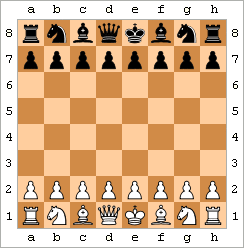Fool's mate
In chess, Fool's Mate, also known as the Two-Move Checkmate, is the checkmate in the fewest possible number of moves from the start of the game. This can be achieved only by Black, who can deliver checkmate on move 2 with the queen. Fool's Mate received its name because it can only occur if White commits an extraordinary blunder. Even among rank beginners, the mate almost never occurs in practice.
Example
Fool's Mate – White is checkmated.
|
 | ||||||||||||||||||||||||||||||||||||||||||||
An example of Fool's Mate consists of the moves:
resulting in the position shown. The pattern can have slight variations; Black could play ...e6 or ...e5, and White could play f4 rather than f3. Additionally, the order in which White advances their f- and g-pawns could be alternated.
Similar traps
Similar mating patterns can occur early in the game. For example, in 1. e4 g5 2. d4 f6?? 3. Qh5#, the basic Fool's Mate pattern is the same: a player advances their f- and g-pawns, which permits the enemy queen to mate along the unblocked diagonal. One such Fool's Mate is widely reported to have occurred in a possibly apocryphal 1959 game between Masefield and Trinka[1] which lasted just three moves: 1. e4 g5 2. Nc3 f5?? 3. Qh5#.[2][3][4][5][6] A similar mate can occur in From's Gambit: 1. f4 e5 2. g3? exf4 3. gxf4?? Qh4#.
Teed vs. Delmar
| a | b | c | d | e | f | g | h | ||
| 8 |  | 8 | |||||||
| 7 | 7 | ||||||||
| 6 | 6 | ||||||||
| 5 | 5 | ||||||||
| 4 | 4 | ||||||||
| 3 | 3 | ||||||||
| 2 | 2 | ||||||||
| 1 | 1 | ||||||||
| a | b | c | d | e | f | g | h | ||
A well-known trap in the Dutch Defence occurred in the game Frank Melville Teed vs. Eugene Delmar, 1896:[7]
- 1. d4 f5 2. Bg5 h6 3. Bf4 g5 4. Bg3 f4
It seems that Black has won the bishop, but now comes ...
- 5. e3
Threatening Qh5#, a basic Fool's Mate.
- 5... h5 6. Bd3?!
Probably better is 6.Be2, but the move played sets a trap.
- 6... Rh6??
Defending against Bg6#, but ...
- 7. Qxh5+!
White sacrifices his queen to draw the black rook away from its control of g6.
- 7... Rxh5 8. Bg6#
Greco vs. NN
| a | b | c | d | e | f | g | h | ||
| 8 |  | 8 | |||||||
| 7 | 7 | ||||||||
| 6 | 6 | ||||||||
| 5 | 5 | ||||||||
| 4 | 4 | ||||||||
| 3 | 3 | ||||||||
| 2 | 2 | ||||||||
| 1 | 1 | ||||||||
| a | b | c | d | e | f | g | h | ||
A similar trap occurred in a game published by Gioachino Greco in 1625:
- 1. e4 b6 2. d4 Bb7 3. Bd3 f5? 4. exf5 Bxg2? 5. Qh5+ g6 6. fxg6 Nf6??
Opening up a flight square for the king at f8 with 6...Bg7 would have prolonged the game. White still wins with 7.Qf5! Nf6 8.Bh6 Bxh6 9.gxh7 Bxh1 (9...e6 opens another flight square at e7; then White checks with 10.Qg6+ Ke7) 10.Qg6+ Kf8 11.Qxh6+ Kf7 12.Nh3, but much slower than in the game.[8]
- 7. gxh7+! Nxh5 8. Bg6#
See also
References
- ↑ The names are also recorded as Mayfield or Mansfield and Trinks or Trent depending on the source consulted.
- ↑ Mike Fox and Richard James (1993). The Even More Complete Chess Addict. Faber and Faber. p. 177.
- ↑ Winter, Edward (2005). Chess Facts and Fables. McFarland & Co. pp. 253–254. ISBN 978-0-7864-2310-1.
- ↑ Edward G. Winter (August 2006). "Chess Notes 4493. Short game".
- ↑ Edward G. Winter (August 2006). "Chess Notes 4506. Short game (C.N. 4493)".
- ↑ Averbakh, Yuri Lvovich; Beilin, Mikhail Abramovich (1972). Путешествие в шахматное королевство (in Russian). Fizkultura i sport. p. 227.
- ↑ Teed vs. Delmar
- ↑ Lev Alburt (2011). Chess Openings for White, Explained. Chess Information Research Center. p. 509.
Further reading
- Hooper, David; Whyld, Kenneth (1996) [First pub. 1992]. The Oxford Companion to Chess (2nd ed.). Oxford University Press. ISBN 978-0-19-280049-7.